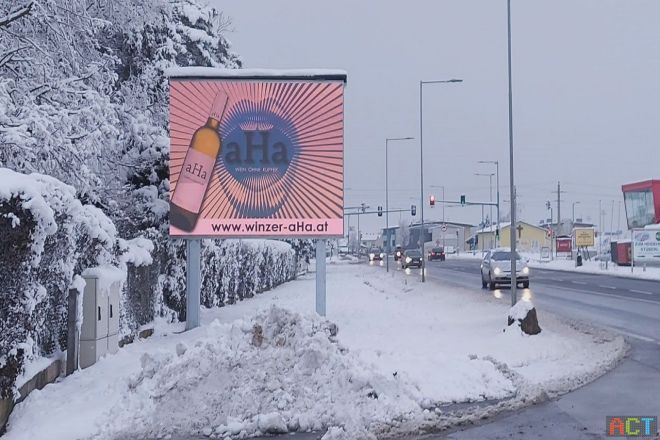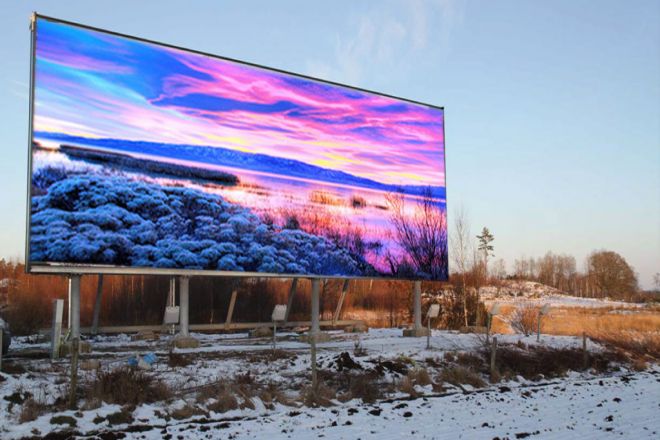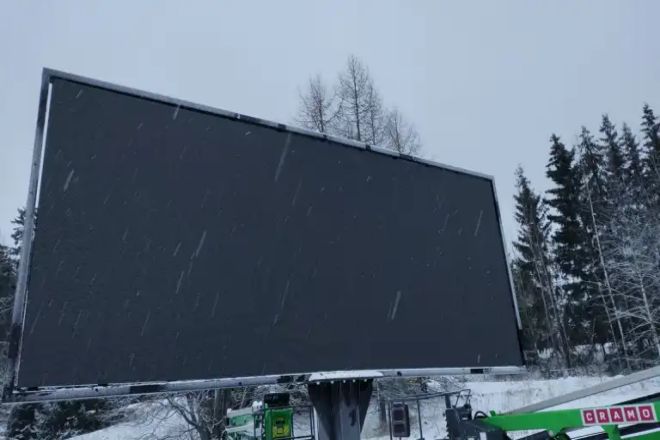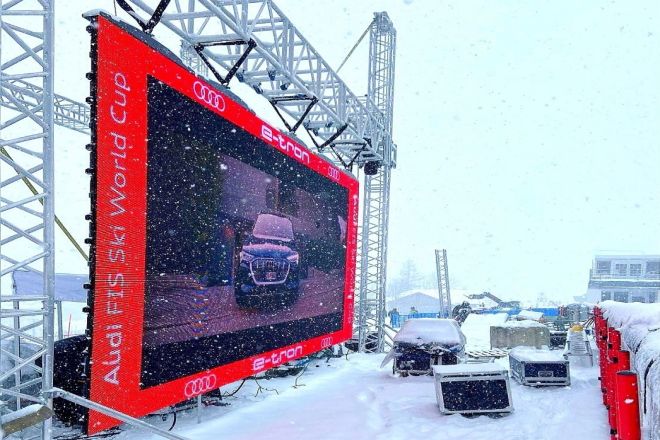Introduction

In the cold winter or high humidity environment, the LED display faces the severe challenge of frosting. Frosting not only seriously affects the visual effect of the display, but also may damage the circuits and components of the display, shorten its service life, and even cause safety accidents.
Therefore, how to effectively prevent and deal with the frosting problem of LED display has become a headache for buyers.
This article deeply analyzes the frosting phenomenon and its causes and proposes a series of practical prevention and response measures to provide strong guarantees for the safe and stable operation of LED displays. Let’s take a look!
1. Under what circumstances will the LED display be frost?

The LED display will frost under certain environmental conditions, and the main situations are as follows:
- Low temperature and high humidity environment
When the ambient temperature drops below freezing, water vapor in the air easily condenses into ice crystals on the cold surface. If the LED display is exposed to such a low-temperature environment and its surface temperature is below freezing, frost may occur.
Under low-temperature conditions, if the ambient humidity is high, the water vapor content in the air will also increase accordingly, which increases the possibility of water vapor condensing into frost on the surface of the display.
- Lack of protection measures
If the LED display is directly exposed to the cold outdoor environment and there is no effective shielding (such as windshields, buildings, etc.) to block the cold air and moisture, then its surface is more likely to frost.
Although ventilation helps to reduce the temperature inside the display, in a low-temperature and high-humidity environment, poor ventilation may aggravate the frost on the surface of the display.
- Factors of the display itself
The sealing of the display has an important impact on its moisture-proof performance. If the sealing of the display is not good, moisture can easily enter its interior and condense into frost on the cold surface.
The LED display will generate a certain amount of heat when it is working. If its heat dissipation performance is poor, resulting in uneven surface temperature of the display or local temperature is too low, it may also cause frost.
- Fourth, other factors
Due to the influence of geographical location and seasons, some areas have extremely low temperatures and high humidity in winter. In such an environment, LED displays are more likely to frost.
In rainy and snowy weather, if there are water droplets on the surface of the display and the temperature drops below freezing, these water droplets will quickly condense into ice crystals and form frost.
2. How to deal with frost on LED displays

1). Safe power off
- First, before dealing with the frosting problem, you must ensure that the LED display is completely powered off. This is to prevent electric shock accidents during the defrosting process and ensure the safety of the operator.
2). Gentle defrosting
Use a soft cloth or sponge: Gently wipe the frost on the surface of the display screen, and avoid using sharp or hard objects to scratch the display screen.
Avoid excessive force: During the defrosting process, operate gently to avoid physical damage to the display screen.
Consider using a heater: If the frost is difficult to remove, you can consider using a heater (adjusted to a low temperature) to blow air to the display screen from a distance to accelerate the melting of the frost. However, you need to be careful to maintain an appropriate distance to avoid high temperatures from damaging the display screen.
3). Inspection and repair
Check the status of the display screen: After the frost is removed, carefully check whether the display screen has physical damage, such as cracks, water stains, etc. At the same time, power on the display screen to test whether the display effect, brightness, color, etc., are normal.
Repair damaged parts: If you find that the display screen has damaged parts, you should contact professional maintenance personnel in time to repair or replace them.
4). Strengthen preventive measures
In order to prevent the LED display from frosting again, the following preventive measures can be taken:
Improve environmental conditions: Try to install the display in a location that avoids direct exposure to cold and humid environments, such as using windshields, buildings, etc., for shielding.
Install a heating system: Install heating elements such as electric heating films, heating tubes, etc. inside or around the display to increase the surface temperature of the display and prevent frost.
Use dehumidification equipment: Place a dehumidifier near the display to reduce ambient humidity and reduce the possibility of water vapor condensing on the surface of the display.
Regular inspection and maintenance: Regularly inspect and maintain the display to ensure that its sealing, heat dissipation performance, etc. are in good condition. At the same time, clean the dust and dirt on the surface of the display in time to keep it in good working condition.
3. How to effectively prevent the LED display from frosting
In order to effectively prevent the LED display from frosting, you can start with the following aspects:
1). Environmental control
1.1). Site selection and shielding:
Choose a suitable installation location and try to avoid installing the display in humid and frosty locations, such as low-lying areas or vents.
Use windshields, buildings, or other shelters to block cold air and moisture from blowing directly to the display screen, reducing the risk of surface temperature drop and frost.
1.2). Temperature and humidity monitoring:
Equip a temperature and humidity detector at the display installation site to monitor the temperature and humidity around the screen in real time.
According to the monitoring results, the environmental conditions should be adjusted in time, such as turning on the dehumidifier to reduce humidity or taking other measures to increase the surface temperature of the display screen.
2). Heating and insulation
2.1). Install the heating system:
Install heating elements such as electric heating film and heating tube inside or around the display screen to increase the surface temperature of the display screen and prevent frost.
The heating system should have an intelligent temperature control function that can automatically adjust the heating intensity according to the ambient temperature to avoid overheating or excessive energy consumption.
2.2). Insulation design:
Use insulation materials to wrap or cover the display screen to reduce heat loss and improve the insulation performance of the display screen.
The insulation material should be waterproof, moisture-proof, corrosion-resistant, and other characteristics to ensure its long-term effectiveness.
3). Dehumidification and ventilation
3.1). Use a dehumidifier:
Place a dehumidifier near the display screen to reduce ambient humidity and reduce the possibility of water vapor condensing on the surface of the display screen.
Dehumidifiers should be cleaned and maintained regularly to ensure their normal operation and dehumidification effect.
3.2). Strengthen ventilation:
Ensure that air circulates around the display screen to avoid moisture accumulation. This can be achieved by installing ventilation equipment or adjusting the installation position.
Note that the design of the vents should be reasonable to prevent cold air from blowing directly onto the surface of the display screen.
4). Regular inspection and maintenance
4.1). Check the status of the display screen:
Regularly check whether the sealing, heating system, ventilation equipment, etc. of the display screen are working properly.
Timely discover and repair potential water leakage, air leakage, and other problems to prevent moisture from entering the inside of the display screen.
4.2). Cleaning and maintenance:
Regularly clean dust, dirt, and other debris on the surface and inside of the display screen to maintain its good heat dissipation performance and visual effect.
Use soft cloth and detergent when cleaning, and avoid using hard objects to scratch the surface of the display screen.
5). Other precautions
5.1). Avoid long-term shutdown:
Try to avoid the display screen being in a shutdown state for a long time, because the surface temperature of the display screen will drop rapidly when it is shut down, increasing the risk of frost.
If a long-term shutdown is required, insulation measures should be taken in advance, or the heating system should be turned off to reduce energy consumption.
5.2). Choose cold-resistant materials:
- When purchasing a display screen, materials and accessories with cold-resistant properties should be given priority to improve their stability and reliability in low-temperature environments.
4. Warm tips

When defrosting, pay attention to the following points to prevent damage to the LED display screen.
Avoid using hot water or steam to spray the display screen directly: This may cause the surface temperature of the display screen to rise sharply, resulting in uneven thermal stress, thereby damaging the display screen.
Pay attention to operational safety: During the defrosting and repair process, pay attention to operational safety to avoid accidents such as electric shock and falls.
Prevent moisture penetration: During the defrosting process, be careful to prevent moisture from penetrating into the interior of the display screen. If there are water droplets remaining on the surface of the display screen, wipe it with a dry cloth in time to prevent moisture from entering the interior of the display screen and causing short circuits or corrosion.
Don’t forcefully peel off the frost: If the frost is thick or difficult to remove, do not forcefully peel it off or use excessive force. This may cause damage to the surface of the display screen or loosen the internal structure. You can try to use warm water (note that it is not hot water) to gently spray on the frost, and then wait for it to melt naturally.
Inspection and testing: After defrosting, carefully check whether there are scratches or damage on the surface of the display, and power on to test whether its display effect, brightness, color, etc. are normal. If there is any abnormality, contact professional maintenance personnel in time for processing.
Conclusion
In summary, although the problem of frost on LED displays is difficult, it is not insurmountable. Through scientific and reasonable preventive measures and timely and effective treatment methods, we can significantly reduce the impact of frosting on the display and ensure its normal operation and long-term use.
At the same time, we should also see that with the continuous advancement of technology and the innovative application of materials, the weather resistance and adaptability of LED displays will continue to improve, providing us with more stable and efficient display solutions in various extreme environments.
Finally, if you want to know more about LED displays, please get in touch with us.
